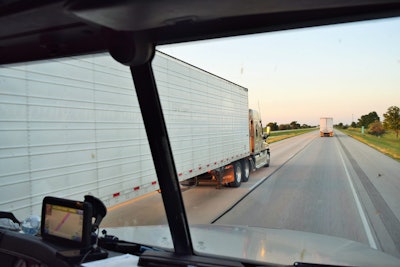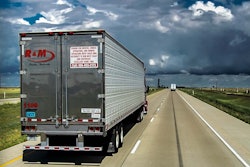
Two of the Department’s sub-agencies — the National Highway Traffic Safety Administration and the Federal Motor Carrier Safety Administration — have teamed up to produce a rule that will at least cover most new trucks, if not a large chunk of truck already on the road today. It will require them to activate or install a speed-limiting device on their truck’s engine, with the maximum speed set at whatever the DOT prescribes in its final version of the speed limiter rule.
In its long-awaited rule proposal, issued Friday but yet unpublished in the U.S. Federal Register, NHTSA and FMCSA asked industry stakeholders and the public at large to weigh in on the rule.
The agencies did not formally propose a speed to which trucks should be limited, but they did issue analysis on three speeds: 60 mph, 65 mph and 68 mph. FMCSA and NHTSA say they hope to receive feedback from trucking stakeholders about the three speeds or any others that could work as the final limited speed.
The agencies also did not propose a timeline for implementation for the rule or offer insights into how long the development of a Final Rule would take. The proposal, which (as noted in prior CCJ coverage) is bare bones for a proposed rule, has been in the works since early 2014.
A Final Rule would take months, if not years, to develop, and the DOT calls for a three-year implementation period. So the speed limiter mandate itself is unlikely to take effect until 2020 at the earliest, given the pace government agencies work to produce such regulations.
The agencies will formally publish the proposal in the coming days, and the rule will have a 60-day comment period for public commenters to provide feedback. Below are the DOT’s arguments in favor a speed limiter mandate, along with what trucks will likely be covered under the mandate. CCJ plans to publish more analysis from other, non-DOT sources next week.
Speed analysis
The slower the truck, the greater the fuel savings and the greater the safety benefit, the DOT argues in its Aug. 26-issued proposal.
Per the DOT’s analysis, a 60 mph limit would prevent between 162 and 498 on-highway deaths a year. A 65 mph limit would see between 63 and 214 deaths prevented, according to the DOT, and a 68 mph limit would prevent between 27 and 96 lives a year. All three speeds would prevent thousands of injuries a year, too, the DOT says.
Again, these figures come from DOT analysis. CCJ plans to report in-depth next week on several other studies performed by non-DOT-affiliated groups, such as the Owner-Operator Independent Drivers Association, the Virginia Tech Transportation Institute, the American Transportation Research Institute and others. Some groups contend speed limiters have negative impacts on highway safety, given that they would create unsafe speed differentials on U.S. roadways and promote so-called “rolling roadblocks.”
The DOT also touts in its proposed rule the fuel savings benefits of speed limiters. At 60 mph, tractor-trailers would save between $2,500 and $6,100 a year on fuel, the DOT estimates. At 65 mph, those figures fall to between $1,400 and $3,000, and at 68 mph a tractor-trailer would use between $640 and $1,400 less in fuel, the DOT purports.
NHTSA and FMCSA also say the rule would help drivers avoid coercive actions from shippers, receivers and carriers who ask truckers to speed to make up time.
1999 and later? Equipment under the mandate
The DOT proposal calls for all trucks weighing more than 26,000 pounds to be covered by the mandate. Manufacturers would set the speed — whatever the final decided speed is — at the factory.
NHTSA calls for a 3-year window between the rule’s final publication and the implementation period to give truck and engine makers time to comply with the rule’s stipulations.
FMCSA’s portion of the rule would cover trucks already in use. It would also have a 3-year implementation period.
The breadth of the retroactive requirements of FMCSA’s portion of the rule, however, are not yet set. The agency notes in the rulemaking that all trucks manufactured in 1999 and later are equipped with electronic engine controls that allow for the truck’s speed to be governed. To retrofit vehicles made before 1999 would likely result in about a million trucks needing a retrofit device that costs between $100 and $2,000, according to FMCSA.
The retrofit requirements, in addition to the maximum speed, is one of the key elements where the agencies seek feedback. The DOT wants stakeholders to report on the feasibility of retrofitting pre-1999-year-model trucks with speed limiting devices, the costs associated with such and whether such devices are tamper-resistant.
The 60-day public comment period officially opens when the rule is published in the Federal Register, likely to be next week. CCJ will post a link to the public comments page when the rule is published.












